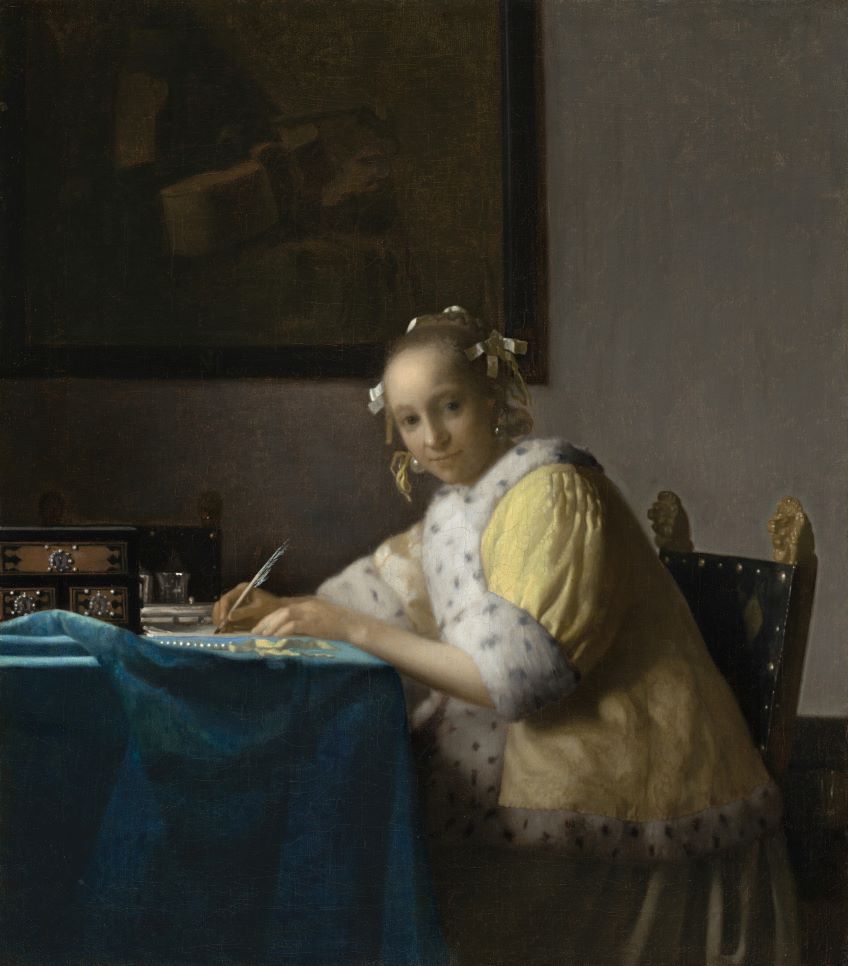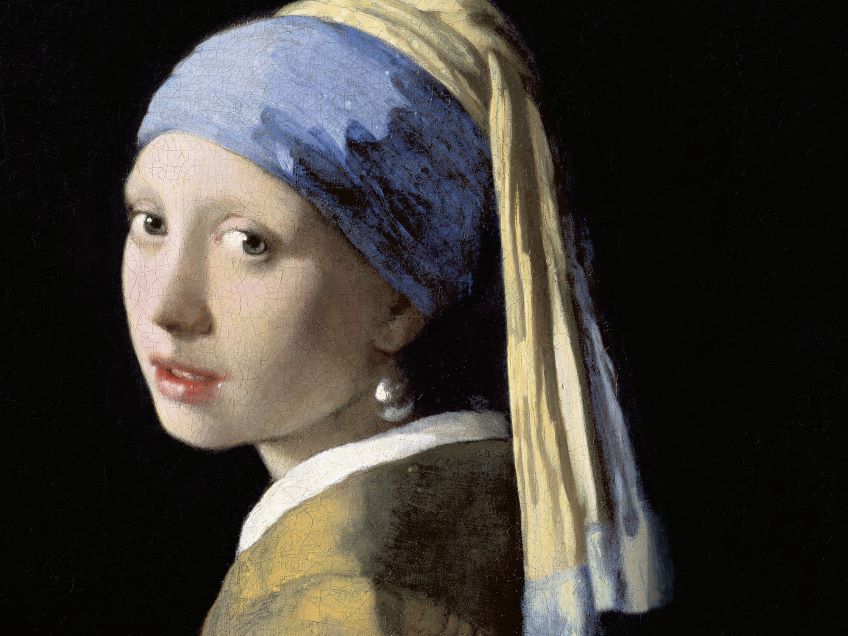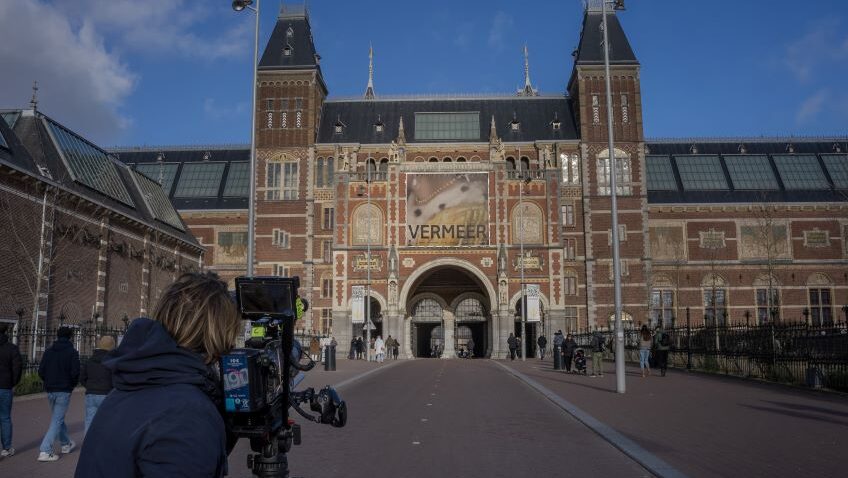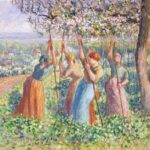Joyce Glasser reviews Vermeer: The Greatest Exhibition (in cinemas April 18, 2023) Cert PG, 92 mins.
Exhibition on Screen (with Seventh Arts Productions) regularly provide excellent coverage of important art exhibitions in cinemas for audiences unable to attend the real thing. Closer to Johannes Vermeer at the Rijksmuseum (February 10-June 4) is not just another blockbuster or even another sold out blockbuster. It is a once-in-a-lifetime experience for the lucky few around the world who snatched the tickets early, and one that, as the paintings grow more fragile and precious, might never be repeated in anyone’s lifetime. Never before have 28 of the known extant 37 paintings by the 17th century Dutch painter been together under one roof. Nine have had to be omitted and already, on March 30, the Mauritshuis Museum in the Hague reclaimed its top attraction, Girl with the Pearl Earring.
Director (and cinematographer) David Bickerstaff and Producer Phil Grabsky do not alter their format for this monumental exhibition which is kind of a shame. Still, you can understand the decision that, to do justice to the exhibition in 92 minutes they would cover all of the paintings with a roving camera but provide commentaries on about half of them. We get the same high calibre commentators – the top experts from the Rijksmuseum and the UK’s Times’ art critic Rachel Campbell-Johnston – illuminating aspects of the paintings. In this exhibition, which I needed three hours to see properly, you might want longer to linger on each painting than time permits and a bit more insight into the objects in the paintings.
The paintings are not exhibited in chronological order as only three of Vermeer’s paintings –The Astronomer, The Geographer and The Procuress – were dated. A timeline on the museum wall lists the estimated dates and where each of the works is now located. Though not his earliest work, the curators create a narrative by placing the only two extant paintings of Delft, The View of Delft (1660) and The Little Street (1658) first and in their own room.

Consistent with the “closer” theme of the title, and perhaps the Protestant country’s belief in direct access to God, the only barrier separating the viewer from the work is a subtle, half-moon-shaped cordon. Ticket holders will also appreciate the prohibition against annoying lecture groups and the absence of audio guides or wall descriptions to clog up the precious spaces in front of the paintings. But in the film, the rooms are empty for your private tour.
Vermeer was born in 1632 in Delft, where he worked as a painter, art dealer and inn-keeper (inheriting these businesses from his father) and occasional Guild president. He died in Delft in 1675, aged 43, leaving a widow, eleven children, and a pile of debts. The debt was due to the 1674 financial crisis in the Netherlands caused by the wars with the French and the English that prevented him from selling his stock as an art dealer and new work as an artist.
In 1660, however, Delft was a prosperous port town of 23,000 inhabitants and in The View of Delft Vermeer paints it from the perspective of someone arriving by boat in the quiet early morning. There is a sense of stillness, save for a storm cloud racing across the sky. Across the water the gates to the city are in the cloud’s shadow, but beyond, sunlight illuminates the landmark church tower and the rooftops like a spotlight, enticing us into the city. Pieter Roelofs, the museum’s head of Paintings and Sculpture says, ‘if there is one painter where light is colour and colour is light it’s Vermeer; and no one else is doing what he is doing.’
Roelofs compares Vermeer to a film director, telling stories by freezing a moment in time so that we instantly imagine what came just before and what will come after. In research done for the exhibition it was discovered that Vermeer made changes, not in drawings, at least, none survive, but as he painted, sketching in broad outline the narrative and figures or objects and then adding or deleting details. In The Little Street, the children playing, and the red shutter were late additions. Research also suggests he used a camera obscura for focus. In The Lacemaker the focus is on the girl’s (Vermeer almost always used female models) fingers and the two threads, with the sheets of fabric closest to us blurred. In no other painting are we so close to the protagonist – only about a metre away. Research also shows Vermeer enriching the clothing (which clearly distinguishes servants from mistresses or swashbuckling soldiers) with underpainting, even using the expensive ultramarine pigment as underpainting, and to contrast with lead-tin-yellow as in The Milkmaid.
After the views of Delft (The Little Street is a microcosmic look at part of one house on one street in the city suggested by The View of Delft) we get a room of history, mythology and religious paintings that show young Vermeer emulating the old masters, competing with contemporaries and deciding on his direction. The Procuress of 1656 is a rarity in terms of genre painting. He seems to have been influenced by Gerard ter Borch, and Dirck van Baburen who painted the same subject. But the focus is on the active hands which tell the story and on the single gold coin that focuses the eye as though it were Eve’s apple. On the left the smiling chap looking at us might be a self-portrait. If so the 24-year-old is in good company. Jan Steen, who ran a brewery in Delft in the 1650s, frequently included his jovial self in his paintings (As the Old Sing, So Pipe the Young is in the Rijksmuseum).

Vermeer left no diaries, notebooks, letters or documents behind, but it is estimated he completed 45-50 paintings in his short life, of which 37 are known. It is believed he had two main patrons in Delft (which might account for his obscurity in the centuries following his death). When the wealthy Catholic patron Pieter Claesz.van Ruijven’s died a year before Vermeer, his daughter was left twenty Vermeer paintings.
If his output was only two or three paintings a year it was not only because he worked slowly, but because he had other commitments including a large family and two businesses to run. From his mid-twenties he began to specialise in the interior genre paintings that were popular in a country with scant religious idolatry and run by Burghers not a king. Paintings were widely purchased by the middle classes who enjoyed seeing themselves at home. In many of Vermeer’s interiors (he is thought to have used two rooms in the large home his family shared with his Jesuit-leaning mother-in-law) there are landscapes or symbolic moralising Biblical paintings on the walls that contemporaries would have recognised.
The bulk of the paintings are those glorious signature interiors with maps on the walls and open windows reflecting the outside world of trade and the Dutch empire. And of course, the windows indicate the source of light, both metaphorical and literal. Vermeer either invites us into a painting – in Girl Interrupted at Her Music and Lady Writing a Letter from 1665 we are interrupting the women and they look up at us – or turns us into voyeurs peeking through curtains. In Lady Writing a Letter with her Maid the protagonist is unaware she is being seen. But as Pieter Roelofs stresses, Vermeer paints an illusion which is all that we see. It never returns to paint. Rachel Campbell-Johnston marvels that the reflection of light in the world’s most famous earring does not emerge from a brush stroke but from alchemy – ‘it’s magic.’
The mysteries of Vermeer’s work remain. Is the 1661 A Glass of Wine moralising, or entertainment for a dirty old man? What is that flat surface under the lute-playing woman’s dress in The Love Letter? Who are his models? There are five paintings featuring the same model as a prosperous woman wearing a rich yellow ermine-trimmed jacket in which pearl necklaces seem related to her writing and receiving “love” letters. Is there a narrative running through them? And what about that variation on the theme: Woman Holding A Balance (1664)? Here, a woman (with no bored maid awaiting a letter or amused maid delivering one) behind a table full of necklaces? She holds a balance in front of a painting depicting The Last Judgement. Is she breaking up with the suitor (“pearls before swine”) or is she contemplating eternity? The Jesuit St Ignatius of Loyola believed we are most able to love God when we are fully balanced. Vermeer’s last born son was named after the saint.




